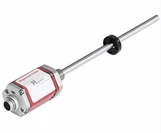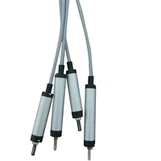Water Level Indicator/ Float Switch
These switches are used to monitor liquid levels by opening or closing when a desired action point is reached. A variety of types are available using mercury and non-mercury tilt switches and, also, permanent magnets and reed switches. Common applications include sumps, pump-control systems, bilge pumps, below ground vaults and irrigation systems.

High-quality stainless steel raw materials, durable and rust-free
304 stainless steel metal elements are stable and free of harmful substances, lead-free, high temperature resistant, and rust-free. The float tube we make of stainless steel has a thick wall, does not deform when bent, has good quality, and is more durable


PTFE high temperature resistant wire
PTFE material can withstand high temperatures of 300 degrees Celsius in a short period of time, and can generally be used continuously between 240°C-260°C. It has significant thermal stability. It can work at freezing temperatures without embrittlement, and at high temperatures it does not Melting, it also has excellent properties of wear resistance and corrosion resistance.
Anti-acid, anti-alkali, anti-fungal, anti-grease.
Imported Reed Switch, High Sensitivity
The high-power reed switch made of imported materials has high sensitivity and a contact life of up to 1 million times. It is durable and not easy to damage.

Features of the level switch
Automatic operation
Water level indicators and float switches operate automatically, eliminating the need for manual monitoring of water levels
Power and cost savings
These devices help save electricity and water by regulating usage, resulting in reduced costs over time
Reliable level detection
They provide accurate and reliable detection of liquid levels, triggering actions when specific high or low levels are reached
Versatility
Water level indicators can be used in various applications, including water tanks, fuel tanks, swimming pools, sewage systems, and industrial processes
Multiple sensor types
There are different types of sensors available, including float switches, probe sensors, and conductivity sensors, allowing for flexibility in different environments.
Control capabilities
Many water level indicators can automatically control pumps, alarms, or other devices based on detected water levels
Material options
Float switches and sensors are available in various materials to suit different liquid types and environmental conditions, such as stainless steel for corrosion resistance.
Installation options
They can be stem-mounted or cable-suspended, allowing for installation in different tank configurations and sizes.
Multiple sensing points
Some systems allow for multiple sensing probes or floats, enabling monitoring of different levels within the same tank.
Safety features
Water level indicators can help prevent issues like pump dry-running, tank overflows, and equipment damage.
Integration with control systems
Many water level indicators can be integrated with building automation systems or PLCs for centralized monitoring and control.
Visual indicators
Some models feature LED lights for easy visual monitoring of system status and water levels.
Applications are everywhere
Float switches can be used in many household appliances in life, such as water purifiers, water dispensers, water heaters, air conditioners and humidifiers, small refrigerators, etc. At the same time, they also have very critical uses in industrial agricultural equipment, petrochemicals, water treatment and other fields.

FAQ
Q: Can we use our own logo?
Q: Could I visit your factory?
Q: How can you make delivery ?
Q: What is the payment term ?
Q: Why is liquid level control important?
Q: What is the importance of water level sensor?
Q: How does a liquid level sensor work?
Q: How does a float type level sensor work?
Q: How long do float switches last?
Q: Where are float switches used?
Q: Why should you install a float switch?


























